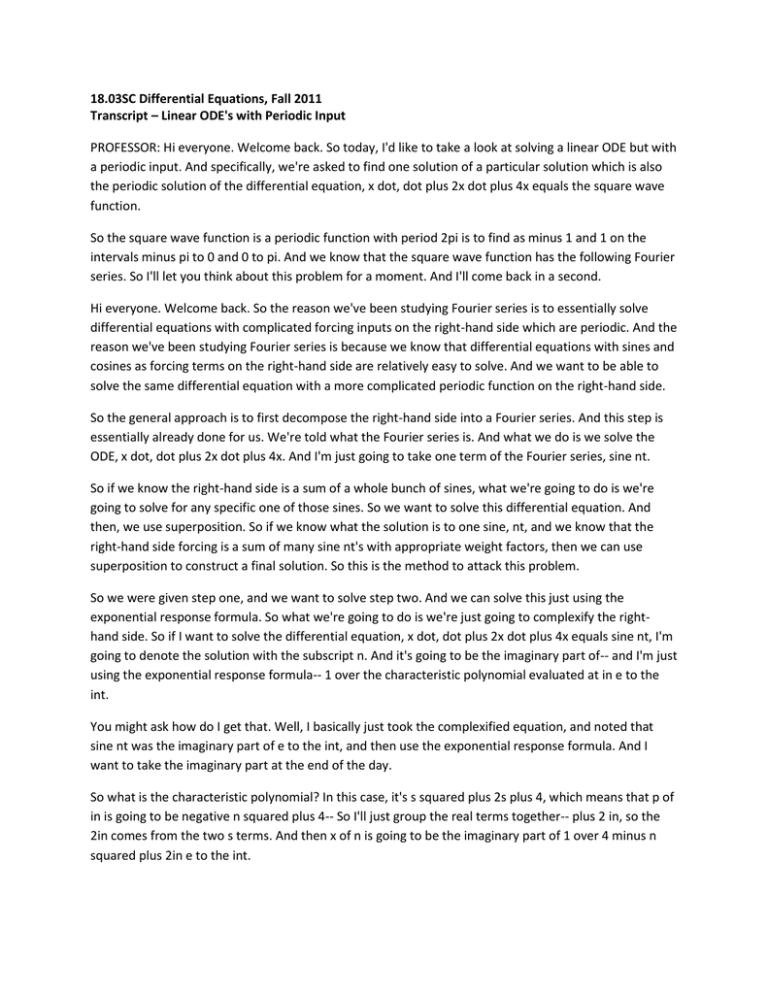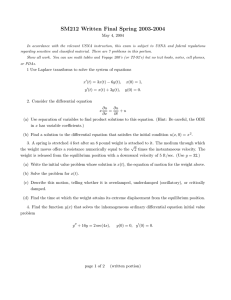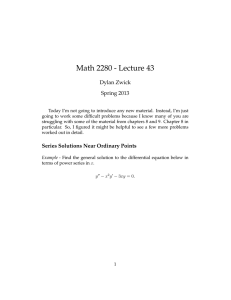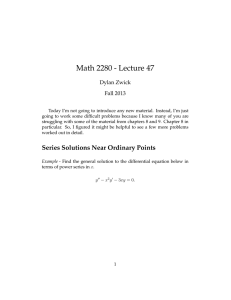18.03SC Differential Equations, Fall 2011
advertisement

18.03SC Differential Equations, Fall 2011 Transcript – Linear ODE's with Periodic Input PROFESSOR: Hi everyone. Welcome back. So today, I'd like to take a look at solving a linear ODE but with a periodic input. And specifically, we're asked to find one solution of a particular solution which is also the periodic solution of the differential equation, x dot, dot plus 2x dot plus 4x equals the square wave function. So the square wave function is a periodic function with period 2pi is to find as minus 1 and 1 on the intervals minus pi to 0 and 0 to pi. And we know that the square wave function has the following Fourier series. So I'll let you think about this problem for a moment. And I'll come back in a second. Hi everyone. Welcome back. So the reason we've been studying Fourier series is to essentially solve differential equations with complicated forcing inputs on the right-hand side which are periodic. And the reason we've been studying Fourier series is because we know that differential equations with sines and cosines as forcing terms on the right-hand side are relatively easy to solve. And we want to be able to solve the same differential equation with a more complicated periodic function on the right-hand side. So the general approach is to first decompose the right-hand side into a Fourier series. And this step is essentially already done for us. We're told what the Fourier series is. And what we do is we solve the ODE, x dot, dot plus 2x dot plus 4x. And I'm just going to take one term of the Fourier series, sine nt. So if we know the right-hand side is a sum of a whole bunch of sines, what we're going to do is we're going to solve for any specific one of those sines. So we want to solve this differential equation. And then, we use superposition. So if we know what the solution is to one sine, nt, and we know that the right-hand side forcing is a sum of many sine nt's with appropriate weight factors, then we can use superposition to construct a final solution. So this is the method to attack this problem. So we were given step one, and we want to solve step two. And we can solve this just using the exponential response formula. So what we're going to do is we're just going to complexify the righthand side. So if I want to solve the differential equation, x dot, dot plus 2x dot plus 4x equals sine nt, I'm going to denote the solution with the subscript n. And it's going to be the imaginary part of-- and I'm just using the exponential response formula-- 1 over the characteristic polynomial evaluated at in e to the int. You might ask how do I get that. Well, I basically just took the complexified equation, and noted that sine nt was the imaginary part of e to the int, and then use the exponential response formula. And I want to take the imaginary part at the end of the day. So what is the characteristic polynomial? In this case, it's s squared plus 2s plus 4, which means that p of in is going to be negative n squared plus 4-- So I'll just group the real terms together-- plus 2 in, so the 2in comes from the two s terms. And then x of n is going to be the imaginary part of 1 over 4 minus n squared plus 2in e to the int. And I'm going to use the amplitude phase form. I'm going to convert this Cartesian complex number into an amplitude phase form just because it's taking the imaginary part of the solution very easy at the end of the day. So the amplitude of this complex number is 4 minus n squared quantity squared plus the imaginary part squared, so that's 4n squared, square rooted. And then, upstairs is eint. And downstairs, it's going to be ei phi. And I'm going to put a subscript n on the phi just because for each complex number, we're going to have a different phase phi. And that phase phi end is going to be the arctangent of 2n divided by 4 minus n squared, like that. So now, I can combine phi of n with the upstairs term, int, in the exponent. And when I take the imaginary part, I'm only going to be left with sine of nt minus phi n. So x of n is going to be 1 over 4 minus n squared squared plus 4n squared quantity squared -- square rooted -- times sine of nt minus phi n, where phi n was given using the arctangent formula. And this gives us a solution, which note is periodic with period 2t. AUDIENCE: [INAUDIBLE]. PROFESSOR: Right. I should also note that phi of n is between 0 and pi. And this gives us the one solution to the differential equation with a forcing of sine nt on the right-hand side. So now what we want to do is we want sum up many of these solutions using the superposition principle. So if I go back now, I'm going to write the original differential equation. So I'm just going to go back and just rewrite this. And I'm going to write the right-hand side using its Fourier series, 1 over n sine nt, where n is odd. And this is the problem we originally wanted to solve. And essentially what we've done is we've solved the problem for each individual sine nt. So how do we get the full solution? Well, what we have to do is we have to multiply the solution for each sine nt by a factor of 4 divided by pi and 1 over n. And then, we have to add all of these solutions up for all odd values of n. So for example, x is just going to be 4 over pi sum of n odd, 1 over n times the solution to every sine nt, which we've already computed, and I've denoted it as x sub n. And x sub n is up here. So if we want to be explicit about it, I'll write the whole thing out as 4 over pi n odd, 1 over 4 minus n squared quantity squared plus 4n squared square rooted. We also have a factor of n out front. We have a sine nt minus phi n. So there's the final answer for a particular solution in its full glorious detail. We can also check that this particular solution is periodic. Note how each sine nt is periodic. And each sine nt has period of at least 2pi. So when we sum up a whole bunch of functions which all have a period of at least 2pi, the sum is also going to be periodic function with at least 2pi. And as a result, this gives us the answer we're looking for. Also, in addition, if we want the full general solution to the differential equation to this particular solution, we also have to add the homogeneous piece. So this concludes the problem. And I'll just quickly recap. When solving a differential equation with a periodic forcing function on the right-hand side, again, to iterate the steps, you first, Fourier decompose the right-hand side into summation of sines and cosines. You then solve the differential equation for sine nt cosine nt individually. This gives you a solution for each term on the right-hand side of the differential equation. And then at the end of the day, you use superposition to sum up all of the solutions. And that gives you one final big solution. So I hope you enjoy this problem. And I'll see you next time. MIT OpenCourseWare http://ocw.mit.edu 18.03SC Differential Equations. Fall 2011 For information about citing these materials or our Terms of Use, visit: http://ocw.mit.edu/terms.



